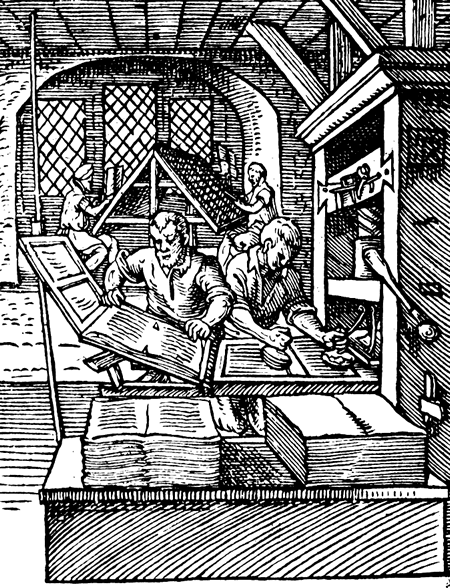 |
| Johann Gutenberg |
The dissemination of knowledge occurred more quickly after Johann Gutenberg invented the printing press in 1440. Gutenberg, the son of a businessman named Friele Gensfleisch zur Laden, was born in Mainz, Germany, and was a goldsmith by profession. Movable type made of wooden blocks had been developed by the Chinese but was a time-consuming process.
In Holland and Prague, experiments on a sophisticated printing process were already taking place. Gutenberg’s goal was to reproduce medieval liturgical manuscripts by using movable pieces of metal blocks for each letter. Many copies of a book were printed without loss of color and design. An assembled page was placed into a frame, and afterward a heavy screw forced the printing block against the paper. He combined paper technology along with oil-based ink.
With the financial backing of a rich German lawyer, Johann Fust, Gutenberg established the first printing press, ushering in an era of enlightenment. A large portion of society received an opportunity to read, and literacy was not confined to church, monastery, and nobility. The labor-intensive hand copying of books was no longer necessary, while the printing of books became fast and inexpensive.
  |
Gutenberg published the 42 Line Bible, or the Gutenberg Bible, in Mainz in 1445 after two years of hard labor. Each column had 42 lines, and the whole Latin Bible had 1,282 pages. He printed 180 copies, out of which 47 are still extant. The words from the original Bible were not changed.
He sold copies of the Biblia Sacra at the Frankfurt Book Fair of 1455. Adolf of Nassau, the elector of Mainz, gave him a benefice in 1465. Gutenberg printed indulgences, slips of paper used by the church. He also produced parts of Aelius Donatus’s Latin grammar, Ars Minor, which had 24 editions. Persons trained by him established their own printing presses.
Within a span of 50 years about 100,000 publications emerged. In libraries, books were to be distinguished from archival materials. Very soon, literacy expanded with the printing of maps, posters, pamphlets, and newspapers. Novel ideas of Renaissance Europe were fostered and preserved. National languages replaced Latin, a change important for the creation of nation-states.
 |
| printing press |
The invention of the printing press was received with opposition from the Catholic Church. The printers of Mainz fled after an attack from soldiers of the archbishop of Nassau in 1462. But European cities benefited from the printers’ skill.
Some of the elite did not want to keep printed books along with hand-copied manuscripts in libraries. This dissipated gradually, and the printing press spread all over Europe. In 1476 William Caxton established the first printing press in England at Westminster.
He published Thomas Malory’s Le Morte d’ Arthur. In the 1480s, a printing press opened in Andalusia, Spain. By the end of the 15th century, the printing industry existed in 250 cities of Europe. The 1,000 printing presses published 35,000 titles and 20 million copies.
   |
Afterward, Roman type styles replaced Gothic types and metal screws were used in place of wooden ones. The printing press in the 15th century was modest compared to a modern press. A standard press having five workers could publish only five books a year, but an important discovery had been made in the history of human civilization.
Statues of Gutenberg adorn many places in Germany and notable institutions are named after him. Gutenberg is credited with transforming medieval Europe into a modern society, bringing about a scientific revolution.